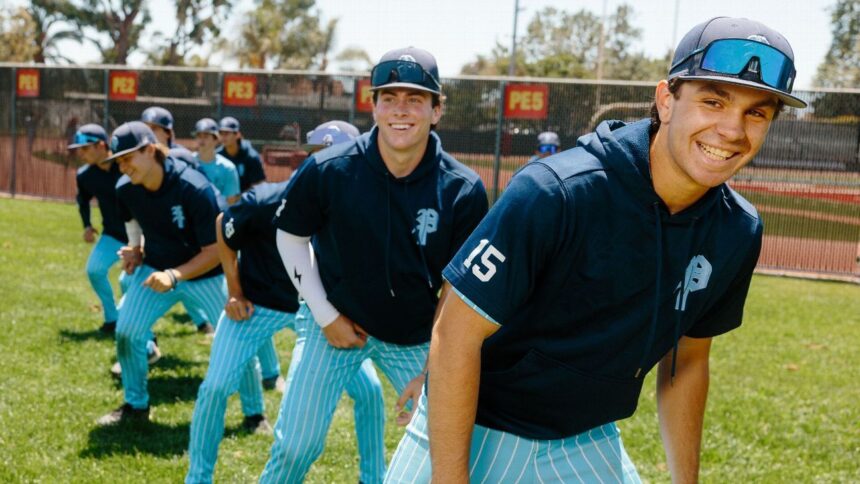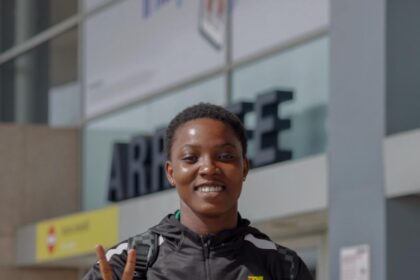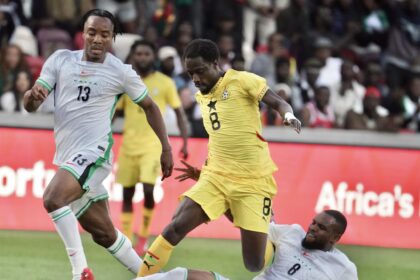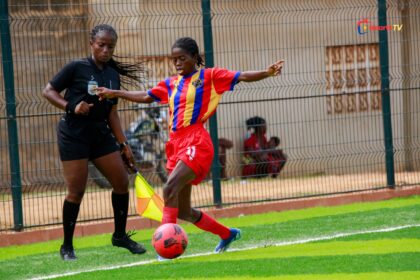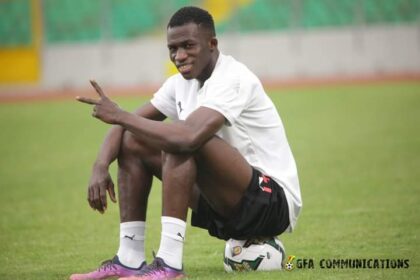LOS ANGELES — With their school burned down and their field demolished, Palisades Charter’s baseball team gathered at Fairfax High on Friday afternoon, for the finale of a regular season spent entirely on the road.
One by one, eight Palisades seniors — a group of players who had their middle school graduation upended by the COVID-19 pandemic, then spent their final high school semester in nomadic chaos after Los Angeles’ unprecedented wildfires — spilled out of the dugout to be recognized. They held roses for their mothers and personalized baseballs for their fathers. Palisades athletic director Rocky Montz introduced them individually, then paused after they had all lined up along the first-base line.
“Quite a year,” he said.
Fifteen of the 42 players who make up the school’s baseball program were displaced in the wake of the Palisades fire, which burned for the final 24 days of January and destroyed 6,837 structures along its path. Staging a baseball season initially felt impossible. Navigating it required uncommon resilience. Completing it was a near miracle.
The Palisades baseball program, among the most distinguished in the area, ran its practices out of public parks and needed permission from a rival school to host Senior Day. Its schedule — which continues with the start of the playoffs on Thursday — required playing as the home team on 15 different fields. And yet, for a group of players who now attend classes out of an abandoned department store, this baseball season, tumultuous and unconventional as it was, became a much-needed constant. It provided what head coach Mike Voelkel described as “a sanctuary, a safe haven.”
“I don’t know where I’d be without baseball right now,” said Ian Sullivan, a senior first baseman and pitcher who lost his home. “People say it’s not healthy to have something that you’re so obsessed with that you can’t live without it, like it’s pretty good to have balance in your life, but with literally my life turned upside down, I don’t know where I’d be if I didn’t have baseball.”
It’ll be at least another 3½ years until Palisades Charter High School is fully operational again. Its baseball program is in serious jeopardy even beyond that; after the field miraculously survived the fires, rollers paved it over to make room for portable classrooms in hopes of getting kids back on campus as quickly as possible. Many of those connected to the program admit that this could mark the Dolphins’ last competitive season in a while, if not ever.
They finished it with a 17-10 regular-season record, punctuated by a mercy rule victory after five innings over the Fairfax Lions. The highlight was when senior first baseman Roman Hawk sent a ball an estimated 370 feet to left-center field, over a 20-foot-tall chain-link fence and beyond a black SUV parked outside of it. Hawk was in tears as he gave hugs and posed for pictures after play concluded. He lives in Brentwood, an area that was not directly impacted by the Palisades fire but whose proximity forced him to evacuate twice. In the ensuing weeks, Hawk saw some of his closest friends absorb the loss of their homes and practically every material item they owned.
By this point, he has fully grasped the importance of simply completing this season.
“Each day brought something new, and we just did it,” Hawk said. “I don’t really know how we did it; I’m just glad we did.”
JETT TEEGARDIN, A junior pitcher and third baseman, woke up on the morning of Jan. 7 to a phone call from his mom, who was at work, telling him to evacuate their home.
“I didn’t take it seriously at all,” Teegardin said. “My biggest worry was that in like three or four days we were going back to school. I was like, ‘I don’t want to go back.’ And then I go outside and I look up and there’s a big cloud of smoke above our house.”
Teegardin waited for his mom and his sister to return home, then threw a pair of sweatpants into a duffle bag, got into his car and spent hours in standstill traffic. The three settled into a hotel 9 miles south, and it wasn’t until Teegardin flipped on the television and saw flames engulfing Temescal Canyon, which borders his neighborhood, that he felt the magnitude of what was occurring.
As news of the devastation spread, Voelkel was flooded with phone calls and messages from coaches and friends from all over the country wondering how they could help. A week later, the California Interscholastic Federation announced it would simplify transfer rules for athletes displaced by the Palisades and Eaton fires, which forced more than 200,000 people in L.A. County to evacuate. Players kept wondering if they would have a season.
“Yes,” Voelkel would tell them. “I don’t know how, but yes.”
Three of Palisades’ four uniform sets were destroyed, as were two sheds stuffed with field tools and a laundry list of equipment — radar guns, buckets of baseballs, fungo bats, helmets. Most pressing of all, though, was finding a new place to play. The Palisades baseball field, which sits in a bowl surrounded by vegetation, was unharmed, but the surrounding damage made it inaccessible.
Voelkel spent his days on the phone trying to piece together a schedule, further complicated by the fact that three of the other six teams in the league didn’t have their own fields. It wasn’t just about securing a venue; it was getting administrators from multiple schools on board, booking umpires, making sure parents approved, and coordinating travel for kids who were not old enough to drive. If one element broke down, the process had to start all over again.
Most of the destinations required long drives, and many came with unforeseen obstacles. (On one occasion, Palisades unknowingly played on a field with a curfew that caused the cancellation of a junior varsity game in the middle of the third inning.) Practices were held at two public parks, the second of which was built for 8-year-olds. It had one batting cage that was always occupied. Bucket lids were used as bases. Midway through, the locals practically turned the outfield into a dog park.
“Very sandlot,” Sullivan said. “It was very funny, but also very frustrating.”
Games were played on weekdays at noon or 1 p.m., in the middle of classes, often the only time they could be accommodated. Schedules were emailed to parents every Sunday, but they were constantly in flux. Voelkel recalled one instance when it changed a dozen times within a span of three days.
The hardest part, senior right fielder Logan Bailey said, was “finding the will to get up every morning, come out to the field and give it your all with everything else going on.”
But the players drew motivation from something bigger.
“We’re not just winning for us; we’re doing this for the Palisades community,” said Joseph Stanley, a freshman third baseman and pitcher on the junior varsity team. “It’s super important to the community. They lost everything, right? And we’re representing it. I take so much pride in it.”
Voelkel has coached baseball for almost 40 years, the past 18 at Palisades. Under Voelkel, the program has claimed 11 Western League titles and boasts a .614 winning percentage. From 2017 to 2024, the Dolphins won 72 consecutive games within their league. This year, though, players frequently had to miss practice and made more unforced errors than he could remember. But they played. And through that, lives in disarray had some semblance of normalcy.
“When we would lose, obviously it would eat me up,” Voelkel said. “But then I would have to stop and go, ‘That doesn’t matter. It does, but it doesn’t.’ So when you talk about the challenges, that was a big challenge for me. But the season — I didn’t care if we were playing on the moon; we were playing.”
Teegardin was among eight players whose home was destroyed by the Palisades fire, which grew to become the most destructive in L.A. County history. In the four months since, he has gone from living out of a hotel room in Marina Del Rey to temporary homes in Fairfax, Sherman Oaks and Mar Vista, where the family is finally settled with a one-year lease.
He misses the little things about his old neighborhood. Where he’d park his car, meet his friends and walk his dog. How he’d look out over the bluffs, stare toward the beach and clear his mind. In his rush to leave the house, he didn’t grab any pictures of his other mom, Carrie, who died of breast cancer when he was just 7. Teegardin finds himself thinking about that often.
Baseball has been a welcomed distraction.
“It’s the best thing I have in my life,” Teegardin said. “I’m so happy for the season right now.”
IAN SULLIVAN WASN’T yet born when Dave Roberts stole the base that ignited an unprecedented comeback in the 2004 American League Championship Series and forever turned him into a legend in Boston. But Sullivan, who was raised a die-hard Red Sox fan, watched every inning of that series, which his father had recorded on videocassettes, all of which were lost on Jan. 7.
Three weeks later, Roberts, now the ‘ manager, stood in front of Sullivan and his teammates and gave a 45-minute pep talk about the road ahead. Roberts implored the players not to make any excuses. He rubbed a hand along one of his arms and told them he had goose bumps thinking about the challenges they would encounter, how it would bring them closer together and strengthen them forever. He then talked about how those characteristics helped his Red Sox overcome a three-games-to-none deficit against the 11 years ago.
“He just seemed exactly like the moments I’ve seen of him in bits and pieces on my TV,” Sullivan said. “He kind of talked about just how a major league roster does it, how one of the best teams in the world does it. And so that was kind of inspiring because he’s human just like us. And the way he’s talking about his guys, they’re also just human. It felt encouraging, especially for us when we were really unsure what our season was going to be like.”
Roberts exchanged numbers with Voelkel that day, and the two texted from time to time over the ensuing weeks. Voelkel congratulated him on his record-breaking extension; Roberts periodically checked in to see how the team was faring.
On April 26, Roberts turned his bobblehead night into an opportunity to invite the team onto the field to watch the Dodgers go through defensive work and batting practice. Teegardin threw out the ceremonial first pitch. Four junior varsity players whose homes burned down stood behind home plate for the pregame ritual of yelling, “It’s time for Dodger baseball!” into a microphone.
“These are formidable years for these kids,” Roberts said. “Sports, high school, is a big part of my memories. And so I was just very sympathetic toward these young men that this tragedy that happened — I just was trying to encourage them to not let it define their high school years. Because it’s not just the seniors, but their school is not going to be there for the foreseeable future. I just didn’t want it to affect their high school experience. And if I can hopefully add some insight or some hope, that’s what I wanted to do.”
Sullivan, a senior pitcher who will play baseball at Emerson College in Boston next year, had just dropped off his aunt at Los Angeles International Airport on Jan. 7 when he saw a plume of smoke above the hillsides. When he arrived at his home, he packed his parents’ wedding album, grabbed one of his baseball gloves and left his house, unaware of the fact he’d never step inside it again. Now, only a hammock and some outdoor furniture remain. Ever since, he has kept his mind occupied by one thought:
Three games.
Dodger Stadium will host the City Section Finals on May 24. And if the Palisades Dolphins can win their first three playoff games, they’ll play there for the first time since 2019.
“We got a taste of it [in April], and I can’t get that taste out of my mouth,” said Sullivan, who has since moved with his family to three different places, including their current spot in Manhattan Beach. “I want to play there so bad.”
IN THE SUMMER of 2007, Voelkel sold his real estate company, packed a U-Haul and moved his family to L.A. to facilitate his wife’s and his son’s acting careers. He initially accepted a job as the physical education instructor at Palisades and was subsequently asked if he had any interest in coaching the baseball team.
The baseball field was a plateau of dirt and patchy grass with limitless potential then. It neighbored the edge of Sunset Boulevard, the iconic street that connects to Pacific Coast Highway, and was surrounded by a 50-foot-high embankment of palm trees and ivy. “A little bit of Miami and a little bit of Chicago,” Voelkel said. Over the course of two decades, Voelkel fundraised somewhere in the neighborhood of $3 million to improve it. In the early stages, he rented a house two blocks away and worked on the field up to eight hours daily.
An outfield fence and a giant batter’s eye was installed. Netting was placed along foul territory. The infield grass was laser-graded. A warning track, a rarity for local high school fields, was put in. The mound was built so that it would drop gradually, 1 inch for every foot, making it more conducive to arm care.
It became one of the best amateur fields in L.A., and the players worked on it just as much as their coaches did. They leveled the pitcher’s mound and each batter’s box after every usage, dragged sod routinely, lined basepaths before games and patched holes when gophers infiltrated the outfield. It taught them responsibility and ownership, and now, it’s gone.
Palisades administrators and the L.A. Unified School District decided to pave over it to install bungalows that will serve as temporary classrooms for additional students. Trucks arrived on April 24. The field, one of the only parts of the campus the fires spared, was leveled within 24 hours.
“Devastating,” Bailey said.
“It was basically our second home,” Caleb Gitlin, a sophomore infielder, added. “There were days when we’d spend six, seven hours there. We were there sometimes more than we were at our homes.”
Palisades’ main campus, which served roughly 80% of the student body, stayed upright during the fires. But the other 20% used bungalows that burned down. Administrators ultimately decided they would place new ones atop a flat surface created by paving over the field, believing it to be the only place that could adequately accommodate them.
The decision triggered outrage from parents who believe some of the bungalows will remain empty because they’ve overestimated potential enrollment; that they didn’t exhaust alternative options; that the plan was approved without consulting those directly involved; and that there hasn’t been enough urgency to find an alternate field with fall baseball approaching. The reality, though, is that the players were on the wrong end of a numbers game, with about 40 of them and roughly 2,500 others.
“Just because it’s a low number doesn’t mean these kids don’t count,” said one parent, who asked not to be identified. “They’ve been through enough. They deserved to play baseball on their field.”
In a statement, a spokesperson for the LAUSD wrote that the portable classrooms will be in place until permanent structures are erected, which is “expected” for the fourth quarter of 2028. “At that time,” the statement read, “the portable classrooms on the baseball field will be removed and the baseball field will be reconstructed, which is anticipated to be completed in 2029.”
School administrators have told parents that they are committed to maintaining a baseball program at Palisades, an independently run charter that rents its lot from LAUSD. But there have not been any solutions, making it more and more likely that next season — and perhaps the ones beyond it — will be just as nomadic as this one.
“I really don’t have words to express the future of the baseball program,” said Voelkel, who expects to retire before a new baseball field is put in place. “That’s probably the most disheartening thing. I think from my standpoint as well as the hundreds of former players that I have is, ‘What’s going to happen next?’ And there’s really no for-sure plan. Just some ideas. That’s the part that really stings is all the time — money, support, work, and all the stuff that goes into it, to be in this place right now is kind of a tough pill to swallow.”
On April 22, after 14 weeks of remote learning, Palisades students transitioned into an old Sears building that sits adjacent to the famous Santa Monica Pier. The store opened in 1947 and shut down in 2017. Now, 2,500 high school students occupy four floors, taking classes within drywall cubes that don’t have doors, every sound reverberating through the building.
Voelkel was told to run his P.E. class out of the parking lot where buses load and unload kids, though often he’ll walk the students about five blocks to a local park. Parents are skeptical about the administration’s goal of having kids back on the Palisades campus by the start of fall, believing early 2026 to be far more realistic.
The unsettled timeline has only complicated the search for an alternate baseball field. The fact that as many as five of the seven teams in their league won’t have a field next season has essentially left them competing for the same spaces. And the reality of dealing with various sectors — parks and rec programs in Santa Monica and L.A., LAUSD officials, Palisades administrators, etc. — has added another layer of difficulty.
With baseball so uncertain, kids will inevitably transfer.
It’s another obstacle in a year defined by them.
“It’s just a lot to think about,” Teegardin said. “Although I do need to worry about it, I’m just trying to push it off just so I could keep my sanity a little bit. But I need to worry about that. I’ve definitely thought about transferring, but I’ve thought about staying. I love this school. I love Pali so much, and it sucks that I have to think about leaving.”





